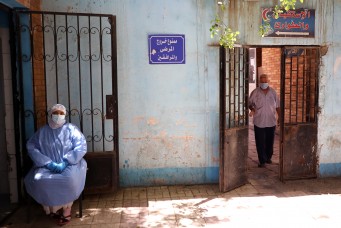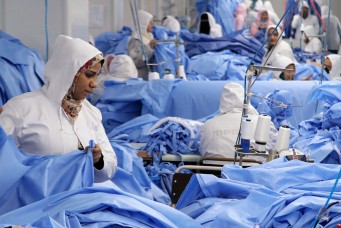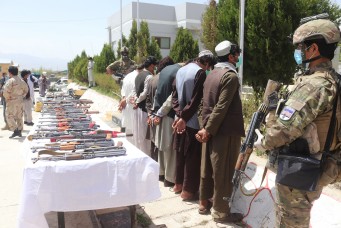The Viral Quotient: How Arab Media Responded to COVID-19
From social media to government narratives, the audience was bombarded with a plethora of information, some of which was confusing and contradictory.

A man wearing a protective face mask, amid concerns over the coronavirus disease (COVID-19) reads Al Joumhouria Newspaper on a street in downtown Cairo, Egypt June 9, 2020. Amr Abdallah Dalsh/Reuters.
In the midst of a crisis being compared to the 1918 Spanish Flu that killed over fifty million, the coronavirus, or COVID-19, was officially labeled a pandemic by the World Health Organization (WHO) on March 11, 2020. As of this writing, the most recent estimates indicate roughly nine million cases globally, with approximately one third of them having occurred in the two hardest-hit nations alone: the United States and Brazil.
In the Arab World, early news coverage of the outbreak mimicked that of most international media outlets by focusing on the cases emerging from outside of the Arab states, particularly China, South Korea, Iran, and Italy. With almost no confirmed cases of the virus in the region by late February, Arab mainstream media initially maintained an air of distance from danger, reporting on the coronavirus as just another segment in their coverage of international news. This, however, was in noticeable contrast to rumors about the virus which were circulating online, particularly through social media networks and WhatsApp. According to Forbes magazine, during the first month of the outbreak, more than fifteen million tweets mentioned coronavirus.
Early Rumors Stoke Division
In Egypt, some social media rumors focused on alleged coronavirus cases on a few university campuses, while the news was breaking about cases and a COVID-19-related fatality among tourists. Photos started circulating on WhatsApp before the mainstream media caught on showing a medical team entering to deal with cases at a local hotel. The hotel in question was shut down almost immediately.
The slow release of official information was not well-received on social media, where Egyptians—over forty million of whom are online—were posting and sharing their own versions of the truth, much of it based on rumors, conspiracy theories and misinformation. This tendency only increased as cases of infections in France, Canada, and elsewhere were reported in individuals who had just returned from Egypt.
On February 16, the country announced its first coronavirus case attributed to a non-Egyptian visitor. There was a clear unanimous tone adopted by various television networks and official news agencies preparing the public for what was yet to come. Three consistent media messages were frequently repeated by many of Egypt’s most prominent television presenters and newspapers: calming the nation with the inevitability of coronavirus cases; confirming the state’s readiness to face the storm; or disseminating precautionary measures for the public to integrate into their daily lives to protect themselves.
While some of the troubling content and misinformation online has been similar to what has been seen elsewhere, such as documented instances of racism against individuals of Asian descent and bogus remedies for the virus, some other content has taken on a unique and worrying form.
Beginning in March, the hashtag #Qatar_fe_Corona was being used on Twitter by many in the Gulf region to express anger and distrust and allege conspiracies concerning the Qatari government, only stoking existing geopolitical tensions. Some posts have gone so far as to claim Qatar used oil money to create the virus in China as a strategy to derail Dubai Expo 2020 (originally scheduled for October 2020 but postponed for a year due to the pandemic) and Saudi Arabia’s Vision 2030 for national development.
In April, the same hashtag was used to reprimand Qatar for holding Bahrainis in transit from Iran in Doha airport. This came several weeks after videos of individuals kissing and licking Shia shrines in Iran went viral, causing concern that such content would only serve to exacerbate Sunni–Shia tensions in the region.
In Saudi Arabia, as elsewhere, officials have been struggling to combat false cures for the virus found on social media. A Ministry of Health spokesperson lashed out aggressively against individuals circulating unproven herbal remedies for the illness, and in March, the public prosecutor warned that those posting false information could face criminal charges including jail time or large fines.
While often caught in a vicious circle of tit-for-tat accusations against their representative governments, regional mainstream media outlets have done their part since the outbreak of the pandemic to dispel dangerous online rumors by encouraging audiences not to believe reports from disreputable sources and even sharing positive content to disrupt the dissemination of false and stereotypical information. Saudi news network Al Arabiya, for example, broadcast an Arabic video of a Chinese student in Lebanon who had been the victim of racism and coronavirus stereotyping and included a segment of Lebanese officials expressing their support for Chinese expats in the country.
Despite this convergence between social and mainstream media to combat Sinophobia and malicious online content, there has nonetheless been inconsistent and misaligned information about the coronavirus between the two.
Inconsistencies Raise Questions Around Transparency
With mixed messages emerging, there was speculation of a media blackout in parts of the region. Earlier in the crisis, when almost no cases had been reported in the Arab region, some took to social media to question government transparency as reports of positive cases began to emerge. Others questioned why the virus had thus far seemed to be disproportionately affecting the developed world, with almost no infections in Africa and the Middle East.
This online buzz was followed by government action by the end of February. In Egypt, after cases of individuals having recently left the country testing positive began to emerge, Egyptian Health Minister Dr. Hala Zayed told Amr Adib on his popular nightly talk show El Hekeya that, while cases were appearing in individuals who had spent time in Egypt, the origin of these cases were not from the country. Still, she said, all precautions were being taken and international standards applied in accordance with the WHO to ensure containment of the virus.
Traditional media maintained its focus on showcasing strategic preparations and precautionary measures undertaken by the Egyptian government in collaboration with the country’s vital institutions. This was one of the strategies employed in an attempt by official media to reverse longstanding issues of credibility and transparency.
In Morocco, despite unity across the political spectrum on action taken to combat the virus, such as quarantine measures and a declaration of a state of emergency, opposition parties have criticized a lack of transparency and sufficient information by the government. This criticism lies primarily in a lack of participation by institutions and alternative voices in the public response to the crisis. In a statement, the Progress and Socialism Party called for the government to “ensure the presence of the voices of political forces in the public media…and the intensification of news and awareness programs on television and public radio channels, opening the way for political parties to contribute to them, in order to perpetuate democracy, unity and national cohesion in the face of the pandemic.”
Despite some public discourse, deflection of national and social responsibility in both spreading and containing the virus appeared until recently to be a common strategy in regional mainstream media. Apart from the case mentioned above of the Chinese student, there has been a seemingly disproportionate focus on foreign nationals living inside or visiting Arab states as a cause for concern. In Saudi Arabia, where all pilgrimage was banned on March 4, the milestone of more than one thousand infections was reached on March 27. State news websites attributed the vast majority of these early cases to Turkish nationals under quarantine in the city of Mecca.
Despite Challenges, Coordination Yields Results
Since its initial steps, Saudi Arabia has been applauded by many for its swift and coordinated response to the crisis. The monarchy’s tight control over the country has helped facilitate a coordinated response from the government, private sector, and religious authorities. Authorities have been guiding citizens to rely on official sources of information. This has included encouraging citizens to use the Health Ministry’s application “Mawid” to stay up to date on what to do if they exhibit symptoms of the virus and to help track recent travel.
In Lebanon, political upheaval has to some extent limited a coordinated media policy response, although the authorities have expressed concern that the situation could jeopardize social and food security in the country. With the current government having instituted a nightly curfew, Lebanese citizens have been called on to help those in need. Despite this, citizens have continued to protest while taking precautions to combat the virus, such as wearing masks and maintaining distance.
Recently, Lebanon’s Ministry of Information announced a collaboration with the WHO, UNICEF, and the United Nations Development Program to help combat false information and provide accurate updates to citizens, and has also created a website dedicated to providing news and information on the virus.
Lebanon’s efforts to contain the virus proved successful, as the relatively small number of cases began to decline in April. However, the country is facing a likely more disastrous crisis, with protests intensifying and inflation sharply increasing. Poverty, rising prices, and insecurity have only been exacerbated by COVID-19, with the government now estimating the number of citizens living under the poverty line to be above 70 percent.
In an April article published in Al-Monitor, Walid Ammar, Director General of Lebanon’s Ministry of Public Health, said that the country’s efforts are directed towards delaying the virus’ peak rather than flattening the curve. The government’s precautionary measures extended until May 4, when a gradual reopening was phased in: a move that has resulted in a rise in new cases.
The UAE has attempted to handle the virus using both a unified and a unifying tone. This policy has been consistent, and virtually all government agencies—from the foreign ministry to the ministry of economy, to the health ministry—have told residents that together the country will overcome this difficult period. As elsewhere, the UAE health ministry has been urging people not to spread false information; the ministry’s spokesperson emphasized, “Today we are all responsible for the success of national efforts to combat the coronavirus.”
Vulnerable Populations Singled Out Amid Virus Scare
As the number of cases began to increase across the region, the official media started sounding the alarm for displaced and vulnerable populations. Both regional and international news organizations have begun to focus on the potential catastrophe of the spread of coronavirus in places like Syria (despite denial by the Syrian government of local cases, claiming the army had cleansed the country), Palestine, and the many refugee camps that dot the region. In some cases, such as Palestinian refugee camps in Lebanon, authorities have closed off all entrances and exits.
In a recent press release, nonprofit Medecins Sans Frontieres stated: “the disease may spread very quickly through the region, especially in camps, where people live in large settlements, in overcrowded conditions with little sanitation.” Other outlets have been reporting on the challenges facing refugee populations who were already struggling to make ends meet, as the restrictions imposed by host countries have both increased the prices of goods and left many without income.
While authorities in Lebanon have been struggling to make locals abide by the emergency measures in place, Syrian refugees have often been singled out. Some municipalities have been broadcasting warnings against renting property to Lebanese or Syrian families from other areas of the country. Racism against Syrian refugees has been a significant problem in both Lebanese society and the media since the war began in 2011.
Unpacking the Media Response
It is unclear whether the media response in the region was the result of pressure imposed by social media, a series of events including the presence of several cases of the virus, coordinated media policy, or a mix of the three.
However, even after official reports were released by the health ministries of different countries in the region and the launch of dedicated hotlines and information websites, confusion and doubts about the gravity of the spread have persisted in national, regional, and international social media.
In some cases, this has been exacerbated by the appearance of doctors and other apparent specialists on talk shows, at times sharing conflicting or alarmist information. This trend has, in general, played out in the United States and the United Kingdom as well.
A notion underreported in much of the international coronavirus coverage has been the denial and delayed reactions seen in many affected countries. This is largely attributable to the third-person effect, wherein denial stems from the refusal to acknowledge that ‘this can happen to me too’. The third-person effect has been evident across the globe; just as has happened in the United States, Canada, Australia, and elsewhere, officials and doctors in the Arab world have taken to mainstream and social media to reprimand citizens of regional states for not following safety directives.
While the WHO has applauded Egypt’s efforts in containing the spread of the virus, there have been questions about the low numbers of people being tested. According to information shared by the Egyptian government with the WHO, the number of people tested rose from 224 per one million in mid-April to 1,320 per one million. While Egypt has made strides to increase the number of tests, which may reflect the higher numbers of infections reported per day, it falls behind countries such as South Africa, which tests 5,189 per one million people; Saudi Arabia, which tests more than twelve thousand people per one million; or the UAE, which leads the Middle East and North Africa with 121,000 tests per one million people.
The low number of tests, coupled with the relatively low numbers of recorded infections, has fueled criticism on social media of the coronavirus response of some countries in the region, and even included accusations of denial and conspiracy.
In March, international media reports covering Canadian research have accused Egypt of downplaying the actual number of cases based on “flight data, traveler data, and infection rates.” Egypt responded by denying these claims, and the local Al Watan newspaper reported that a lawsuit was filed against the foreign journalists responsible for the stories. While the Canadian report has since been debunked by one of the researchers involved, this episode helped further foment distrust in mainstream international media sources; the hashtag #GuardianLies was trending on Twitter in mid-March.
Simultaneously, the virtual arena has been packed with positive personal testimonies about Egypt’s precautionary measures, particularly from citizens returning home from abroad as well as audio and visual recordings of physicians sharing their daily interactions with quarantined patients and revealing behind-the-scenes measures applied by the government.
Since initial reporting began in the Arab region, news coverage of the coronavirus has shifted dramatically from standard dissemination of current events to a more participatory approach, wherein many campaigns and public service announcements are repeatedly broadcasted on public and privately owned networks, on social media, and in print media. The same shift is visible on social media, where the once panic-dominated sphere has now become a hub for raising awareness, building on social responsibility, and sharing light-hearted stories of solidarity in crisis. Much of this has likely been the result of intensive government action to limit the spread of rumors as well as the notably nationalistic tone of much of the information being circulated. This has been witnessed in Saudi Arabia and the UAE, where taking precautions and following official sources has been framed as a national duty, and in Egypt, where helping vulnerable people and following directives have been framed as an expression of national pride.
In the Arab region, as with most other places, the media spheres—both traditional and social—have been saturated with information—both valid and fake—regarding the coronavirus. However, the unique and dynamic use of social media in the region, as well as the sociocultural and political climate, has created an environment that has simultaneously allowed for a perhaps unprecedented spread of awareness to all socioeconomic strata and the viral spread of potentially dangerous misinformation: not just for the health of individuals, but for political stability of the region. Still, collaboration, cooperation, and effective government action seem to outweigh the potentially harmful messaging.
Lobna Khairy is a member of the Media Committee at the National Council for Women and an assistant lecturer of New Media at the Modern University for Technology and Information in Cairo. On Twitter: @LobnaKhairy257
Read MoreSarah El-Shaarawi is managing editor of the journal Arab Media & Society and a contributing editor at Africa Is a Country. She is a founding coordinator of the Arab Science Journalism Forum. Her writing has appeared in a variety of publications including Foreign Policy, Newsweek Middle East, The National, and Stranger’s Guide, among others. She is also the winner of the 2022 Dalton Camp essay prize. On Twitter: @SarahElShaarawi
Read More




